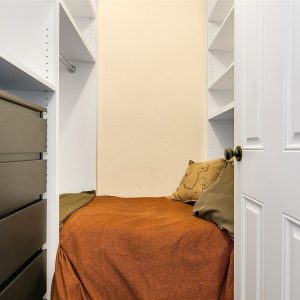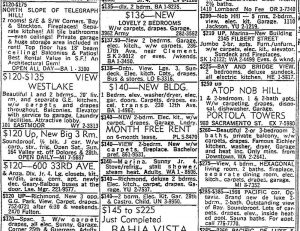Every now and then, a tenant will ask me if he can pay his rent with a credit card. My answer is No. All of my leases state that the rent must be paid by check or money order. I don’t accept credit cards. Why? It’s the bank fees. Most of the new apartment houses in Berkeley and San Francisco allow tenants to pay their rent with credit cards, but that’s because credit card fees are an insignificant expense for them. A 2 bedroom apartment in a new building in downtown Berkeley rents for $4,000 to $5,000 a month, but I’ve seen some that are over $6,000 a month. If I was getting that kind of rent, I would accept credit cards too!
BITCOIN.
A growing number of landlords are allowing their tenants to pay their rent with Bitcoin. I really, really don’t understand that. Cryptocurrencies like Bitcoin are not currencies, they are not money, and they are not legal tender. I don’t know what they are, but I do know that I can’t pay my property taxes, garbage bills, fire insurance, etc. with Bitcoin. I can’t buy cocoa beans with Bitcoin either. I think some businessmen accept Bitcoin because they think it’s tax-free income; however, income that you don’t report on your tax return is not tax-free income. That’s called income tax evasion, not tax-free income. You don’t need to be a CPA to know there’s a difference. Supposedly, Bitcoin transactions and transfers are completely secret and untraceable, but I wonder if that’s really true. I suspect that the IRS has figured out how to crack Bitcoin’s computer codes.
Military Grade Encryption. People tell me that there is no way the U.S. government can get into Bitcoin computer records because they use military grade encryption. But what does that mean? Does ‘military grade encryption’ mean ‘unbreakable’? As you know, I teach history, and history tells me to be very suspicious of unbreakable military codes. For over 5,000 years, governments have been trying to create unbreakable military codes, but without much success. During World War 2, the Germans thought they had an unbreakable military code, but Winston Churchill and Franklin Roosevelt got decoded copies of Hitler’s most secret coded messages to his generals before the generals to whom they were addressed got their decoded copies! That went on all through the war too. During World War 2, the U.S. also broke the Soviet diplomatic code and several Japanese codes.
The Battle of Midway. The biggest naval battle of World War 2 was the Battle of Midway. There will never be another naval battle like that again. The Japanese were hoping to win a decisive victory that would knock the U.S. out of the war. The Japanese thought they were going to catch the U.S. fleet by surprise; however, the U.S. Navy had broken the Japanese naval code, so they knew where and when the Japanese were coming. Instead of ambushing the U.S. Navy, it was the Japanese that got ambushed instead. The U.S. Navy sank all the Japanese aircraft carriers at Midway. As a result, Japan also lost hundreds of their best pilots. After all the Japanese aircraft carriers were sunk, Japanese pilots had no place to land. When they ran out of fuel, Japanese pilots crashed their planes into the sea and drowned. Midway was a disastrous defeat for Japan from which they never recovered. Prior to Midway, Japan was always on the attack. After Midway, they were always on the defense. OK you say, that was then, but what about now? Now we have military grade computer encryption. Well Yes, we do have that, but you know, Vladimir Putin didn’t seem to have much difficulty getting past U.S. computer encryption during the 2016 presidential election. I think that people who do business in Bitcoin in the belief that they are fooling the IRS may actually just be fooling themselves instead.
 The owner of this apartment counted this room as one of the bedrooms in his listing. It is, in fact, just a walk-in closet. Yes, it is a room, and the landlord has put a bed in it, but that doesn’t make it a bedroom. I tell landlords not to engage in this sort of deception. This isn’t going to fool anyone. Nobody is really going to think that this walk-in closet is actually a bedroom just because there’s a bed in it. This is just going to make prospective tenants angry. Everybody hates the feeling that someone is trying to play him for a sucker. The most common form of bedroom inflation is counting a living room as a bedroom. Because of the high rent and housing shortage here in Berkeley, a growing number of college students are sleeping on living room couches. However, just because somebody is sleeping on a futon in a living room doesn’t make that room a bedroom. A living room with somebody sleeping in it is still a living room. I always advise landlords to tell the truth. Its OK for a landlord to brag about the features in his apartment that will make it look more desirable to prospective tenants. I do that. All rational landlords do that. But that’s different than lying or trying to play prospective tenants for suckers. (As you can tell, bedroom inflation is one of my pet peeves.)
The owner of this apartment counted this room as one of the bedrooms in his listing. It is, in fact, just a walk-in closet. Yes, it is a room, and the landlord has put a bed in it, but that doesn’t make it a bedroom. I tell landlords not to engage in this sort of deception. This isn’t going to fool anyone. Nobody is really going to think that this walk-in closet is actually a bedroom just because there’s a bed in it. This is just going to make prospective tenants angry. Everybody hates the feeling that someone is trying to play him for a sucker. The most common form of bedroom inflation is counting a living room as a bedroom. Because of the high rent and housing shortage here in Berkeley, a growing number of college students are sleeping on living room couches. However, just because somebody is sleeping on a futon in a living room doesn’t make that room a bedroom. A living room with somebody sleeping in it is still a living room. I always advise landlords to tell the truth. Its OK for a landlord to brag about the features in his apartment that will make it look more desirable to prospective tenants. I do that. All rational landlords do that. But that’s different than lying or trying to play prospective tenants for suckers. (As you can tell, bedroom inflation is one of my pet peeves.) The owner of this apartment counted this room as one of the bedrooms in his listing. It is, in fact, just a walk-in closet. Yes, it is a room, and the landlord has put a bed in it, but that doesn’t make it a bedroom. I tell landlords not to engage in this sort of deception. This isn’t going to fool anyone. Nobody is really going to think that this walk-in closet is actually a bedroom just because there’s a bed in it. This is just going to make prospective tenants angry. Everybody hates the feeling that someone is trying to play him for a sucker. The most common form of bedroom inflation is counting a living room as a bedroom. Because of the high rent and housing shortage here in Berkeley, a growing number of college students are sleeping on living room couches. However, just because somebody is sleeping on a futon in a living room doesn’t make that room a bedroom. A living room with somebody sleeping in it is still a living room. I always advise landlords to tell the truth. Its OK for a landlord to brag about the features in his apartment that will make it look more desirable to prospective tenants. I do that. All rational landlords do that. But that’s different than lying or trying to play prospective tenants for suckers. (As you can tell, bedroom inflation is one of my pet peeves.)
The owner of this apartment counted this room as one of the bedrooms in his listing. It is, in fact, just a walk-in closet. Yes, it is a room, and the landlord has put a bed in it, but that doesn’t make it a bedroom. I tell landlords not to engage in this sort of deception. This isn’t going to fool anyone. Nobody is really going to think that this walk-in closet is actually a bedroom just because there’s a bed in it. This is just going to make prospective tenants angry. Everybody hates the feeling that someone is trying to play him for a sucker. The most common form of bedroom inflation is counting a living room as a bedroom. Because of the high rent and housing shortage here in Berkeley, a growing number of college students are sleeping on living room couches. However, just because somebody is sleeping on a futon in a living room doesn’t make that room a bedroom. A living room with somebody sleeping in it is still a living room. I always advise landlords to tell the truth. Its OK for a landlord to brag about the features in his apartment that will make it look more desirable to prospective tenants. I do that. All rational landlords do that. But that’s different than lying or trying to play prospective tenants for suckers. (As you can tell, bedroom inflation is one of my pet peeves.)





